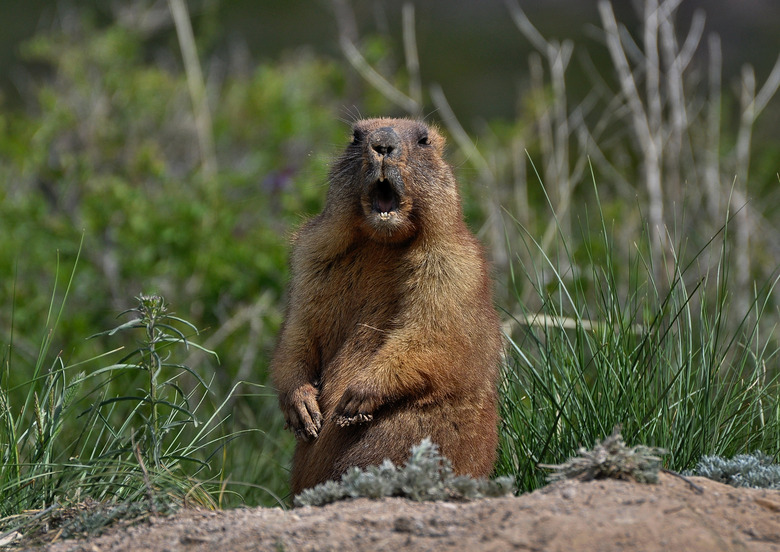What Do Baby Groundhogs Eat?
The diet of a baby groundhog, also known as a woodchuck, consists of mother's milk followed by a weaning diet of grasses and vegetables. As the baby grows, additional foods such as fruits, small insects and nuts will be added to the diet. Baby groundhogs in a rehabilitation setting require a milk substitute followed by weaning on natural foods.
Natural Baby Groundhog Diet
Natural Baby Groundhog Diet
Baby groundhogs are born approximately one month after the groundhog mating season during March and April. The babies are completely dependent on the mother, and they nurse on the mother for an average of four to six weeks after birth. When the babies are weaned at around 6 weeks of age, they begin to consume vegetable matter. During this time they leave the den they were born in, and they venture outside to feed on nutritious cloves, grasses and other easily accessible vegetable foods.
Abandoned Baby Groundhog Diet
Abandoned Baby Groundhog Diet
Abandoned baby groundhogs will be rehydrated with a rehydration solution before they are fed. Once the baby groundhogs are hydrated and able to feed, they are given a puppy milk substitute (specifically Esbilac – available at pet stores and veterinarian clinics). Any other type of milk substitute, including goat, cow, or human milk substitutes can be lethal to the baby groundhog. Tiny amounts must be fed using the right type of technique or the baby can aspirate the liquid.
Growing Baby Groundhog Diet
Growing Baby Groundhog Diet
When the abandoned baby groundhog is ready to be weaned, small amounts of vegetable matter will be slowly introduced into the diet until the baby is completely weaned. Additional vegetables, such as wild grasses, apples and pears, will be added to increase the variety of the growing groundhog's diet. Foods like berries, grubs and nuts can also prepare the groundhog for release.
In nature, baby groundhogs will slowly begin to venture further and further from the den to increase their diet of foraged grasses, vegetables, small insects, nuts and fruits; they will also begin to create their own dens at around 8 weeks of age
Baby Groundhog Considerations
Baby Groundhog Considerations
Never remove a baby groundhog from its environment unless the baby is injured. If you think the baby may have been orphaned, wait and watch to make sure. The East Tennessee Wildlife Rehabilitation Council advises wearing gloves to gently pick up an injured or orphaned baby groundhog; the baby should then be placed in a secure ventilated box on top of a soft cloth and warmed with a heating pad set on low and placed under half of the box — the baby should be able to move away from the heat source if it becomes too hot.
If you find an injured or orphaned baby groundhog, secure the baby and call your nearest wildlife rehabilitation center. Baby groundhogs need special feeding schedules, feeding techniques, diet and care in order to survive. Do not attempt to rehabilitate or feed a baby groundhog yourself; in most states it is illegal to keep wildlife in your home without a permit.
Cite This Article
MLA
Peterson, Jane. "What Do Baby Groundhogs Eat?" sciencing.com, https://www.sciencing.com/do-baby-groundhogs-eat-8392869/. 22 November 2019.
APA
Peterson, Jane. (2019, November 22). What Do Baby Groundhogs Eat?. sciencing.com. Retrieved from https://www.sciencing.com/do-baby-groundhogs-eat-8392869/
Chicago
Peterson, Jane. What Do Baby Groundhogs Eat? last modified March 24, 2022. https://www.sciencing.com/do-baby-groundhogs-eat-8392869/
